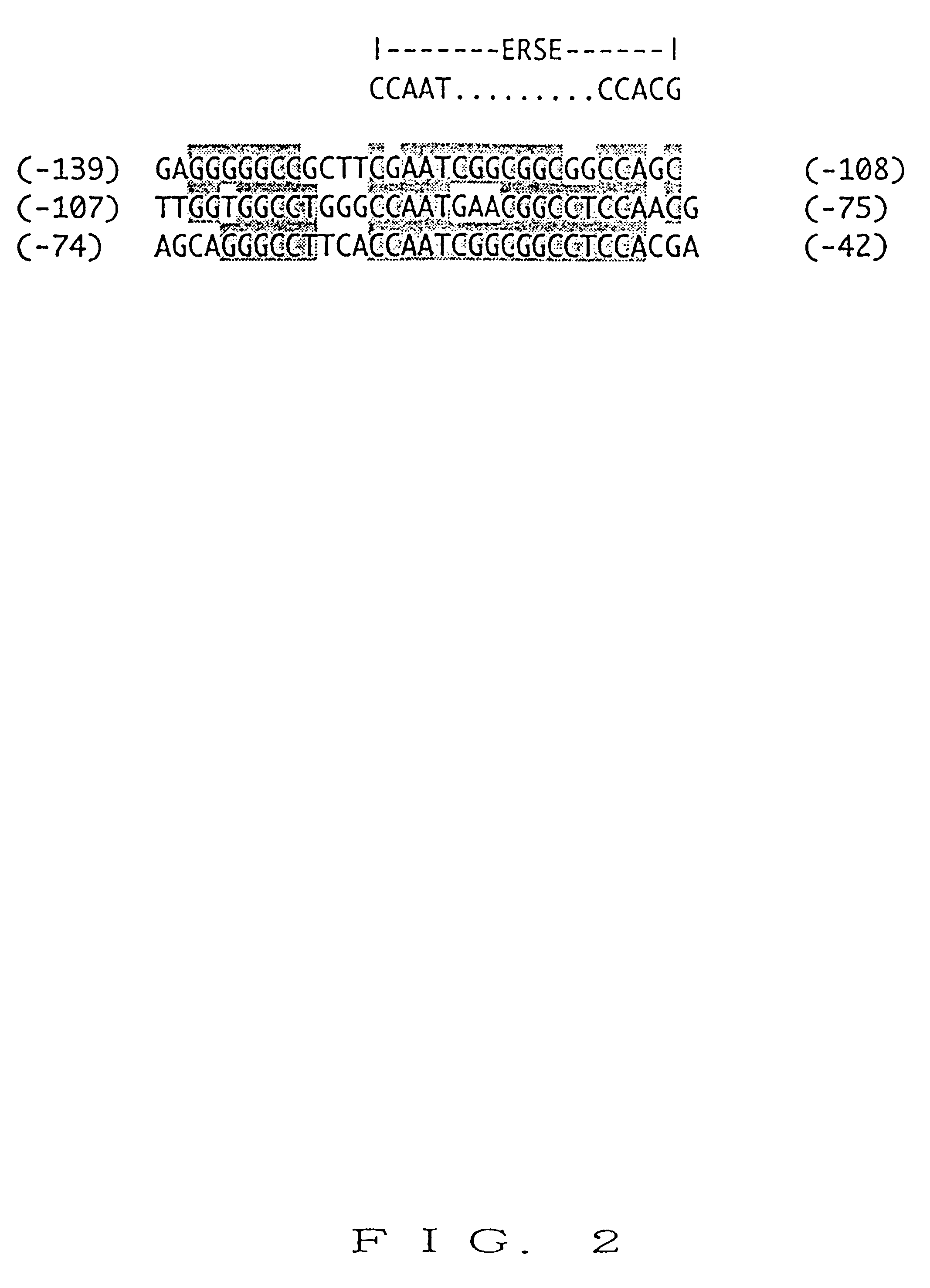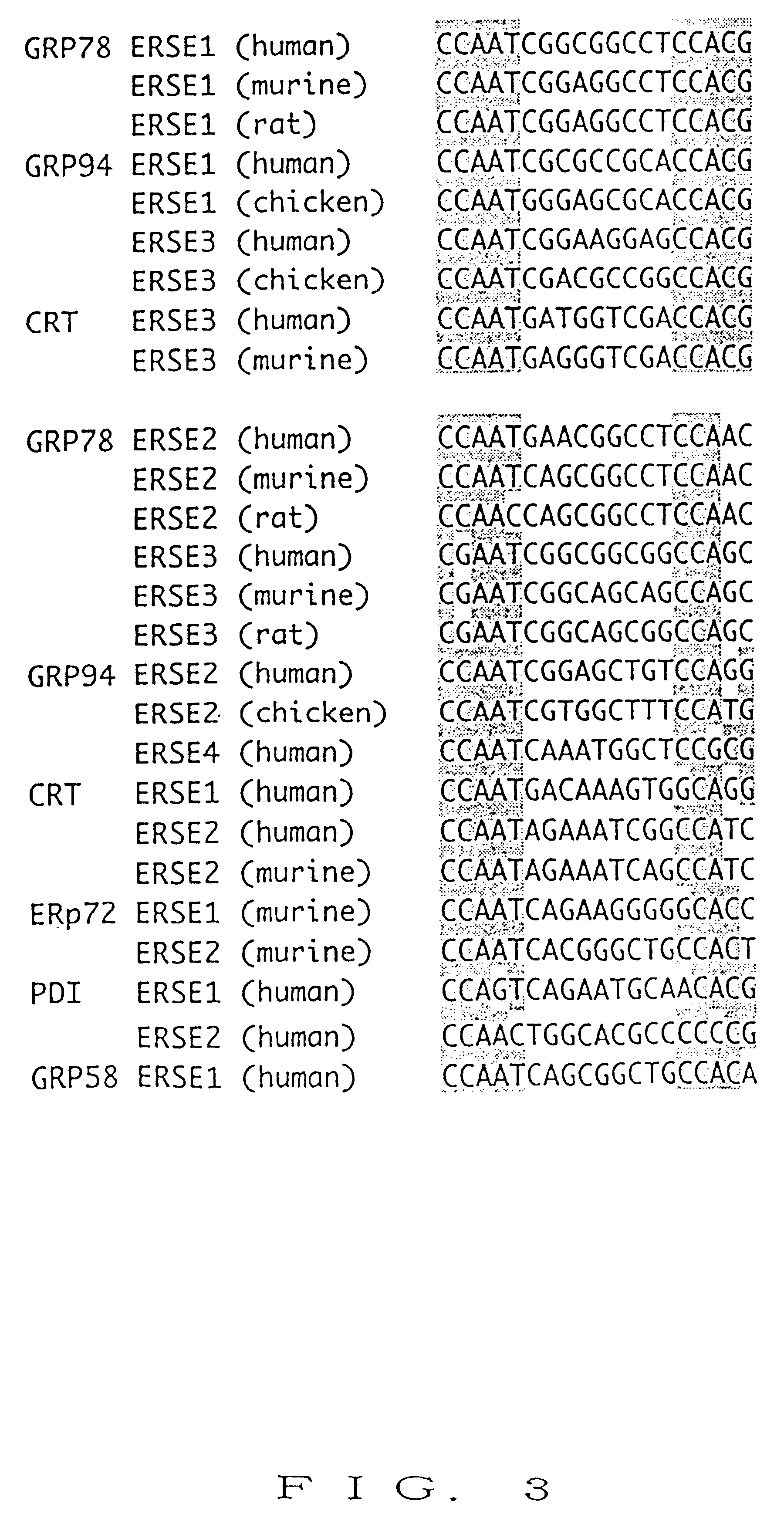Isolated nucleic acids encoding activated and suppressive forms of ATF6
a technology of suppressive and active forms, which is applied in the field of isolated nucleic acids encoding suppressive and activated forms of atf6, can solve the problems of insufficient amount of endoplasmic reticulum chaperones and folding enzymes in usual hosts, and inability to express protein at high levels. to ensure ample protein expression and formation
- Summary
- Abstract
- Description
- Claims
- Application Information
AI Technical Summary
Benefits of technology
Problems solved by technology
Method used
Image
Examples
example 1
Isolation of ERSE
(1) Cell Culture
HeLa cells (ATCC CCL2) were cultured in Dulbecco's modified Eagle's medium (glucose at 4.5 g / l) supplemented with 10% fetal calf serum, 2 mM glutamine, 100 unit / ml penicillin and 100 .mu.g / ml streptomycin, at 37.degree. C. in a humidified 5% CO.sub.2 / 95% air atmosphere.
(2) Construction of Reporter Plasmids for Isolating ERSE Recombinant DNA techniques were performed according to the standard procedures described in Molecular Cloning: A Laboratory Manual Second Edition, Cold Spring Harbour Laboratory, Published in 1989, and the like.
A 311 bp fragment of a human GRP78 promoter ([-304 to +7] region; the nucleotide position of the transcription initiation site is defined as +1) was amplified by PCR method with genomic DNA of HeLa cells as a template using two oligonucleotides as primers for+ strand and- strand, wherein the oligonucleotides were prepared on the basis of the sequence of the human GRP78 gene disclosed by Ting et al. (mentioned above). The ...
example 2
One-Hybrid Screening for cDNA Encoding ERSE Binding Protein
The reporter plasmid for one-hybrid screening was constructed essentially according to the method described by Mori, K. et al. [Genes Cells 1, 803-817 (1996)].
Six tandem repeats of ERSE1 sequence from the human GRP78 promoter [5'-CCTTCACCAATCGGCGGCCTCCACGACGG-3' (SEQ ID NO: 35)] were inserted upstream of the yeast HIS3 gene ligated to the IRE1 promoter, while six tandem repeats of mutant ERSE repeats [5'-CCTTCAgactaCGGCGGCCTgatgtACGG-3' (SEQ ID NO: 36)] were inserted upstream of Escherichia coli lacZ gene ligated to the IRE1 promoter. The structure of the above reporter plasmid is schematically shown in FIG. 11.
The above reporter plasmids were respectively linearized at the NcoI site present in URA3 gene, and one copy thereof was integrated into the ura3-52 locus of yeast strain KMY1015 (MAT.alpha. leu2-3, 112 ura3-52 his3-.DELTA.200 trp-.DELTA.901 lys2-801 irel.DELTA.::TRP1) [Mori, K. et al., Genes Cells 1, 803-817 (1996)]....
example 3
Isolation of Entire cDNA Encoding ATF6 and CREB-RP
A portion of 5'-region of mRNA for ATF6 thought to be lacking in clone #3 was isolated by 5'RACE using HeLa cells RNA. Here, 5'RACE method employed 5'RACE System (manufactured by Life Technologies Inc.). An intact ATF6 cDNA obtained as described above has a length of 2509 bp, and a protein having 670 amino acids was encoded (The accession number for GeneBank Data Base is AB015856). The deduced amino acid sequence was different from the sequence reported by Zhu et al. [Mol. Cell. Biol. 17, 4957-4966 (1997)] by 4 residues which are deduced to reflect an allele polymorphism.
An entire cDNA of CREB-RP having a similar molecular structure and homology in the amino acid sequence is cloned from HeLa cells RNA by PCR on the basis of the published sequence [Min, J. et al., Genomics 30, 149-156 (1995); Khanna, A. et al., Biochem. J. 319, 81-89 (1996)].
PUM
| Property | Measurement | Unit |
|---|---|---|
| Fraction | aaaaa | aaaaa |
| Angle | aaaaa | aaaaa |
| Angle | aaaaa | aaaaa |
Abstract
Description
Claims
Application Information
 Login to View More
Login to View More - R&D
- Intellectual Property
- Life Sciences
- Materials
- Tech Scout
- Unparalleled Data Quality
- Higher Quality Content
- 60% Fewer Hallucinations
Browse by: Latest US Patents, China's latest patents, Technical Efficacy Thesaurus, Application Domain, Technology Topic, Popular Technical Reports.
© 2025 PatSnap. All rights reserved.Legal|Privacy policy|Modern Slavery Act Transparency Statement|Sitemap|About US| Contact US: help@patsnap.com



